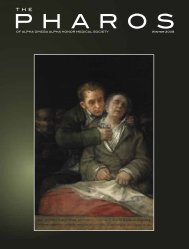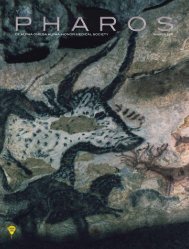Download Selections from The Pharos Autumn 2004 Edition
Download Selections from The Pharos Autumn 2004 Edition
Download Selections from The Pharos Autumn 2004 Edition
- No tags were found...
Create successful ePaper yourself
Turn your PDF publications into a flip-book with our unique Google optimized e-Paper software.
A search of the literature also shows increasingly frequentusage of the phrase. <strong>The</strong> number of citations since 1965 growsprogressively by decade, <strong>from</strong> 18 citations between 1965 and1974 to 118 since 1995. Without doubt, the association betweena concept of “art” and the medical profession parallels recenttrends in medical education, including a more central role ofinterdisciplinary and medical-humanities studies, as well asgreater focus for the student on the patient-physician relationshipand communication skills. 14Most interesting, however, is the wealth of definitions impliedby the phrase “art of medicine” and similar terms. Usingthe semantic technique favored by the creators of the OxfordEnglish Dictionary—searching for a word’s meaning withinthe context of its historical application—one finds a remarkableand often counterintuitive array of definitions withinmedical literature. Here are some common examples:1. Emotional outreach: “[W]hile we wait for the science ofmedicine to help us solve the many mysteries of heart disease,we can use the art of medicine to help blunt the impact ofillness.” 2p12392. Increased communication between physician and patient:“<strong>The</strong> science of medicine involves clinical skills honedthrough reading textbooks and journals and experience indiagnosing and treating myriad diseases. <strong>The</strong> art of medicineinvolves the important communication skills necessary for agood doctor-patient relationship.” 15p245 “We call it an art whena doctor demonstrates the technique of gaining the patient’sconfidence and developing a congenial atmosphere.” 5p12303. Individualized medical care: “To the extent that physiciansmake an explicit effort to understand and appreciatethe ‘life-world’ of patients, and even to modify medicalrecommendations in order to maximize the meaningfulnessand goodness-of-fit of these recommendations, the ‘art’ ofmedicine also becomes an essential part of routine clinicalpractice.” 12p2254. Traditional clinical methods: “Through systematictreatment combining the traditional art of medicine withmodern technology, the physician should generally be able tocare for the premier voice professional.” 16pvSemantic (im)precisionAll of these applications seem to drift far <strong>from</strong> the rigidHippocratic concept of “art” or technai described above.One reason for this discrepancy is grammatical. In ancientGreece, scholars sought to establish medicine as one of “thearts.” “Medicine” is a descriptive term in these translations,and “the art of medicine” is placed alongside “the art of mathematics”—medicineand mathematics both being types of art.By contrast, contemporary users favor an inverse relationship;“art” is a component of medicine, a part of the whole discipline(by implication, so is “science”).A second discrepancy appears to be a function of how wehave come to define “art” in our own time. More than anyother era, the last century equated “art” with imagination,improvisation, creativity, and even revolution. All of thesethemes, at least superficially, seem out of place or even dangerouswhen applied to a modern clinical practice. 4 As did theancient philosophers, we admire rigorous method, whetherin the form of prospective randomized trials or in basic scienceresearch. Given this, it seems ironic that we continue toembrace and endorse a phrase that almost negates the preciseapplication of knowledge in clinical practice. Indeed, a 1999study indicates that one of the barriers to the use of evidencebasedmedicine in clinical practice was the “negative impacton traditional medical skills and ‘the art of medicine.’ ” 17p236Compared with each other, the citations presented aboveappear inconsistent, even unrelated. Nevertheless, commonthemes present themselves in these examples and in similarcontemporary papers. In particular, two stand apart. First, topractice “the art of medicine” is to promote individual patientcare. Patients are physically and physiologically singular. 18<strong>The</strong>ir life circumstances remain unique. 12 Second, the art ofmedicine facilitates communication. This communicationtakes place between physician and patient. 15 <strong>The</strong> communicationis person-to-person, 3 and its quality can be enhanced byreaching out emotionally to the patient. 2,13 *<strong>The</strong> indefinable but real part ofpracticing medicineAt first glance, the variety of contexts in which medicineis juxtaposed with an idea of “art” suggests that we no longerreally know what we mean by the term. <strong>The</strong> themes presentedabove aim to define our contemporary concept of the “art ofmedicine” by examining the way in which caregivers have appliedit. <strong>The</strong>re is a certain vagueness to the themes. In fact, wemight say that one can never define “the art of medicine” withcertainty—its meaning can only be approximated.In the face of such semantic imprecision, the Hippocraticphilosophy of medicine and contemporary professionalismhave this in common: caregiving necessitates moral virtue inaddition to (or even beyond the bounds of) technical dexterity.This moral aspect of clinical care includes the practice of compassionand empathy. 19 It distinguishes medicine that attempts* Notably, in medical literature, authors generally limit thesedescriptions of communication to the physician-patient relationship;of course, communication facilitated by “the art of medicine”could also extend to physician-physician or physician-communityrelationships.<strong>The</strong> <strong>Pharos</strong>/<strong>Autumn</strong> <strong>2004</strong> 29














